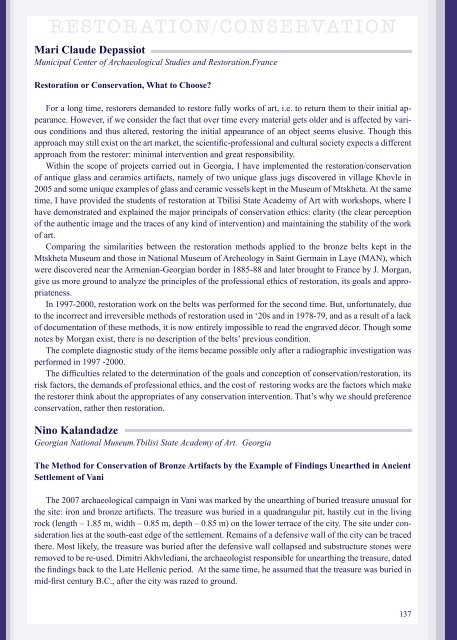Abstracts - International Initiative for Georgian Cultural Studies
Abstracts - International Initiative for Georgian Cultural Studies
Abstracts - International Initiative for Georgian Cultural Studies
Create successful ePaper yourself
Turn your PDF publications into a flip-book with our unique Google optimized e-Paper software.
RESTORATION/CONSERVATION<br />
Mari Claude Depassiot<br />
Municipal Center of Archaeological <strong>Studies</strong> and Restoration.France<br />
Restoration or Conservation, What to Choose?<br />
For a long time, restorers demanded to restore fully works of art, i.e. to return them to their initial appearance.<br />
However, if we consider the fact that over time every material gets older and is affected by various<br />
conditions and thus altered, restoring the initial appearance of an object seems elusive. Though this<br />
approach may still exist on the art market, the scientific-professional and cultural society expects a different<br />
approach from the restorer: minimal intervention and great responsibility.<br />
Within the scope of projects carried out in Georgia, I have implemented the restoration/conservation<br />
of antique glass and ceramics artifacts, namely of two unique glass jugs discovered in village Khovle in<br />
2005 and some unique examples of glass and ceramic vessels kept in the Museum of Mtskheta. At the same<br />
time, I have provided the students of restoration at Tbilisi State Academy of Art with workshops, where I<br />
have demonstrated and explained the major principals of conservation ethics: clarity (the clear perception<br />
of the authentic image and the traces of any kind of intervention) and maintaining the stability of the work<br />
of art.<br />
Comparing the similarities between the restoration methods applied to the bronze belts kept in the<br />
Mtskheta Museum and those in National Museum of Archeology in Saint Germain in Laye (MAN), which<br />
were discovered near the Armenian-<strong>Georgian</strong> border in 1885-88 and later brought to France by J. Morgan,<br />
give us more ground to analyze the principles of the professional ethics of restoration, its goals and appropriateness.<br />
In 1997-2000, restoration work on the belts was per<strong>for</strong>med <strong>for</strong> the second time. But, un<strong>for</strong>tunately, due<br />
to the incorrect and irreversible methods of restoration used in ‘20s and in 1978-79, and as a result of a lack<br />
of documentation of these methods, it is now entirely impossible to read the engraved décor. Though some<br />
notes by Morgan exist, there is no description of the belts’ previous condition.<br />
The complete diagnostic study of the items became possible only after a radiographic investigation was<br />
per<strong>for</strong>med in 1997 -2000.<br />
The difficulties related to the determination of the goals and conception of conservation/restoration, its<br />
risk factors, the demands of professional ethics, and the cost of restoring works are the factors which make<br />
the restorer think about the appropriates of any conservation intervention. That’s why we should preference<br />
conservation, rather then restoration.<br />
Nino Kalandadze<br />
<strong>Georgian</strong> National Museum.Tbilisi State Academy of Art. Georgia<br />
The Method <strong>for</strong> Conservation of Bronze Artifacts by the Example of Findings Unearthed in Ancient<br />
Settlement of Vani<br />
The 2007 archaeological campaign in Vani was marked by the unearthing of buried treasure unusual <strong>for</strong><br />
the site: iron and bronze artifacts. The treasure was buried in a quadrangular pit, hastily cut in the living<br />
rock (length – 1.85 m, width – 0.85 m, depth – 0.85 m) on the lower terrace of the city. The site under consideration<br />
lies at the south-east edge of the settlement. Remains of a defensive wall of the city can be traced<br />
there. Most likely, the treasure was buried after the defensive wall collapsed and substructure stones were<br />
removed to be re-used. Dimitri Akhvlediani, the archaeologist responsible <strong>for</strong> unearthing the treasure, dated<br />
the findings back to the Late Hellenic period. At the same time, he assumed that the treasure was buried in<br />
mid-first century B.C., after the city was razed to ground.<br />
137



